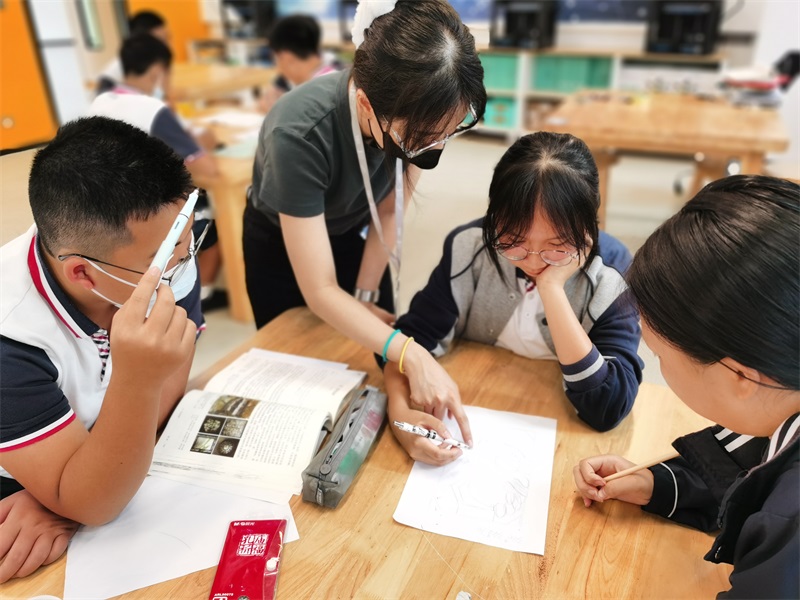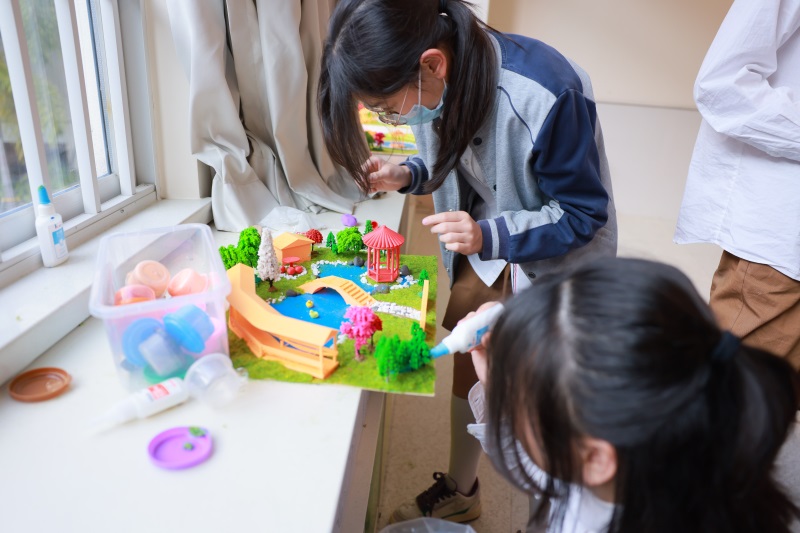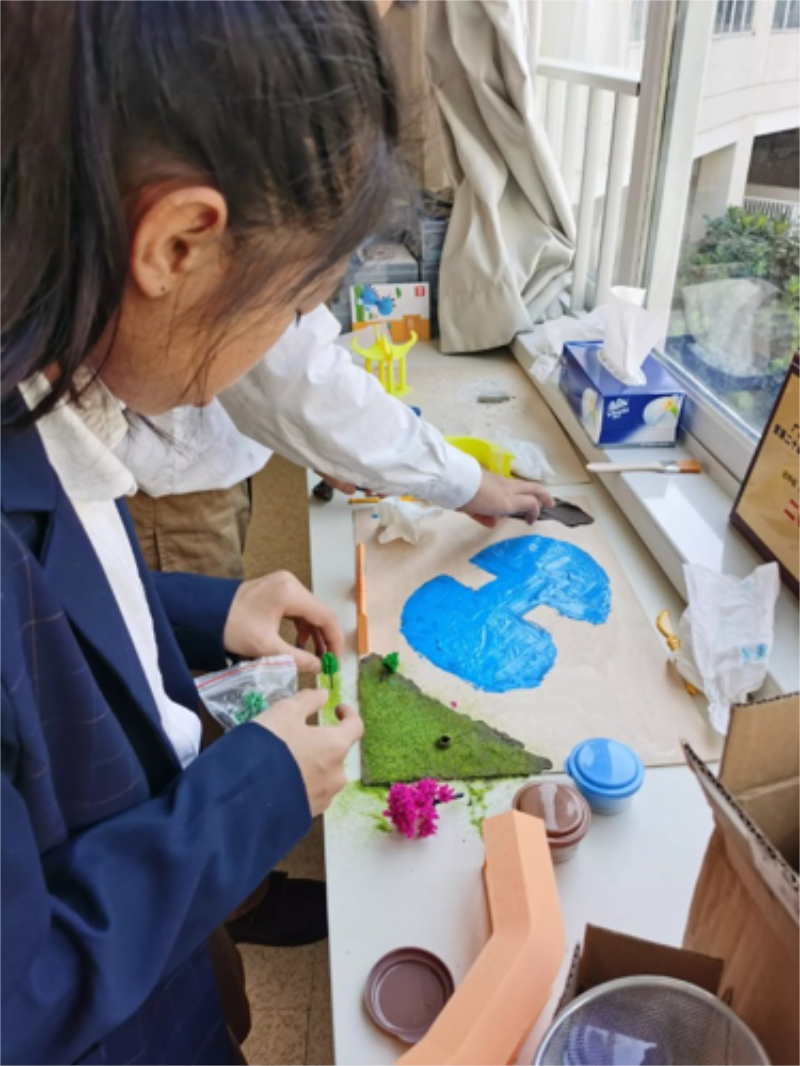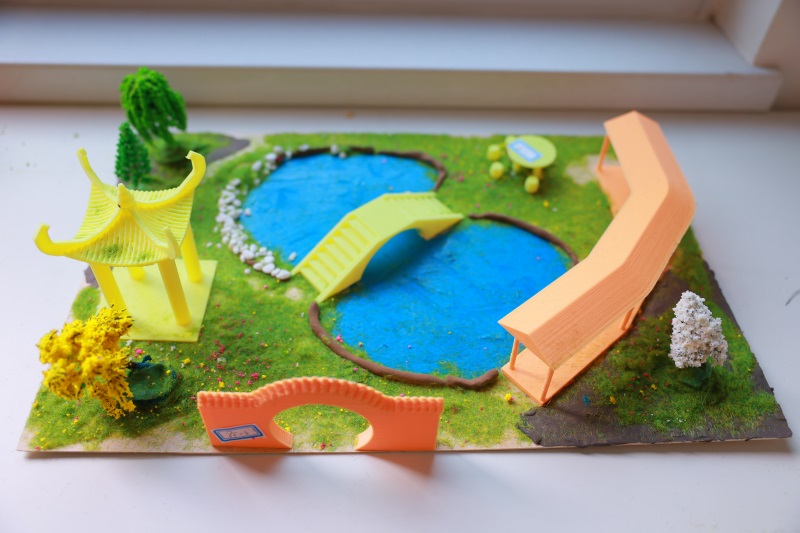 新闻详情
新闻详情
 新闻详情
新闻详情

万双网讯 “中国园林这么美,能否自己设计并建造一座中国园林呢?”万科双语学校八年级学生在学习《苏州园林》之后,结合学校人工智能课上的3D打印,加上建筑课对中国园林的设计,开展了语文、建筑、人工智能相融合的STEM+ PBL项目式学习。
VBS Net News "Chinese gardens are so beautiful, can I design and build a Chinese garden by myself?" After learning "Suzhou Gardens", the eighth grade students of Vanke Bilingual School combined the 3D printing in the school's Artificial Intelligence class and the design of Chinese gardens in the Architecture class to carry out STEM+ PBL project-based learning that integrates Chinese, Architecture, and Artificial Intelligence.
本次项目式学习从2022年12月22日开始,至2023年2月底结束。项目一开始,学生在语文课上学习《苏州园林》时,就要用思维导图总结出中国园林特点,初步感知中国园林的魅力。
This project-based study started on December 22, 2022 and ended at the end of February 2023. At the beginning of the project, when students studied "Suzhou Gardens" in Chinese class, they had to use mind maps to summarize the characteristics of Chinese gardens and initially perceive the charm of Chinese gardens.



在建筑课上,建筑老师深入讲解中国园林的造园要素、园林设计的原则。经过建筑老师指导,学生通过小组讨论,画出自己的园林设计图。“这个亭子该放哪,楼阁朝哪边,小桥架在何处?”在这个过程中,大家都积极讨论思考,相互评比修改,每个小组都出炉了自己心中理想的中国园林设计稿。




在人工智能课上,学生使用3D设计软件,设计并制作出园林中的建筑物。人工智能教室的大黑板变成了管理项目进度的项目墙,清晰地呈现着资料、小组分工、小组进度等情况。小组成员在小组长的组织下,每节课开始根据各自能力、兴趣不同,认领不同的设计任务,组员之间相互帮助,共同推进任务进展。
In the Artificial Intelligence class, students use 3D design software to design and make buildings in the garden. The big blackboard in the Artificial Intelligence classroom has become a project wall for managing project progress, clearly showing information, group division of labor, group progress, etc. Under the organization of the team leader, the team members claim different design tasks according to their abilities and interests at the beginning of each class, and the team members help each other to advance the task progress together.






经过5周的学习、制作,各小组的园林终于成形啦!在最后组装环节,学生将多周辛苦设计的作品组合到一起,装点上花草树木。看,亭台楼阁已然次序坐落在一座座精巧的的中国园林之中了。
After 5 weeks of study and production, the gardens of each group have finally taken shape! In the final assembly session, the students put together the works that have been designed through many weeks of hard work, and decorated them with flowers, plants and trees. Look, terraces and pavilions are already located in the exquisite Chinese gardens.



最后一节课,学生进行了精彩的展示。以园林设计者及导游的身份,带着台下的游客进入自己设计的园林。“这里是曲径通幽的小径,走到尽头是一座亭子,给人一种‘山穷水尽疑无路,柳暗花明又一村’的感觉……” 学生饱含深情的介绍赢得了一阵阵热烈的掌声,同学们仿佛都被带进了那个曲径通幽的园林!
In the last class, the students made a wonderful display. As a garden designer and tour guide, lead the audience visitors into the garden designed by yourself. "This is a winding path leading to a secluded path, and there is a pavilion at the end, giving people a feeling of 'there is no way out, the willows are dark and the flowers are bright, and there is another village'..." The students' affectionate introduction won warm applause, The students seem to have been brought into the garden with winding paths!


最后,同学们对整个项目进行了复盘,反思自己的成长与不足。
Finally, the students reviewed the entire project and reflected on their own growth and shortcomings.

本次PBL项目式学习,有机融合了语文、建筑和人工智能学科,充分调动了学生学习的内驱力,加深了学生对中国园林文化的理解,在3D设计和制作中提升了实践技能,在项目管理中加强了小组合作和自我管理能力。
This PBL project-based learning organically integrates the disciplines of Chinese, architecture and artificial intelligence, fully mobilizes the internal drive of students to learn, deepens students' understanding of Chinese garden culture, and improves practical skills in 3D design and production. Teamwork and self-management skills are strengthened in project management.



指导老师/吴海鸥 黄诗韵 陈艳萍 江泮 成宁
翻译/魏素敏 周金凤
编辑/燕子

万双网讯 “中国园林这么美,能否自己设计并建造一座中国园林呢?”万科双语学校八年级学生在学习《苏州园林》之后,结合学校人工智能课上的3D打印,加上建筑课对中国园林的设计,开展了语文、建筑、人工智能相融合的STEM+ PBL项目式学习。
VBS Net News "Chinese gardens are so beautiful, can I design and build a Chinese garden by myself?" After learning "Suzhou Gardens", the eighth grade students of Vanke Bilingual School combined the 3D printing in the school's Artificial Intelligence class and the design of Chinese gardens in the Architecture class to carry out STEM+ PBL project-based learning that integrates Chinese, Architecture, and Artificial Intelligence.
本次项目式学习从2022年12月22日开始,至2023年2月底结束。项目一开始,学生在语文课上学习《苏州园林》时,就要用思维导图总结出中国园林特点,初步感知中国园林的魅力。
This project-based study started on December 22, 2022 and ended at the end of February 2023. At the beginning of the project, when students studied "Suzhou Gardens" in Chinese class, they had to use mind maps to summarize the characteristics of Chinese gardens and initially perceive the charm of Chinese gardens.



在建筑课上,建筑老师深入讲解中国园林的造园要素、园林设计的原则。经过建筑老师指导,学生通过小组讨论,画出自己的园林设计图。“这个亭子该放哪,楼阁朝哪边,小桥架在何处?”在这个过程中,大家都积极讨论思考,相互评比修改,每个小组都出炉了自己心中理想的中国园林设计稿。




在人工智能课上,学生使用3D设计软件,设计并制作出园林中的建筑物。人工智能教室的大黑板变成了管理项目进度的项目墙,清晰地呈现着资料、小组分工、小组进度等情况。小组成员在小组长的组织下,每节课开始根据各自能力、兴趣不同,认领不同的设计任务,组员之间相互帮助,共同推进任务进展。
In the Artificial Intelligence class, students use 3D design software to design and make buildings in the garden. The big blackboard in the Artificial Intelligence classroom has become a project wall for managing project progress, clearly showing information, group division of labor, group progress, etc. Under the organization of the team leader, the team members claim different design tasks according to their abilities and interests at the beginning of each class, and the team members help each other to advance the task progress together.






经过5周的学习、制作,各小组的园林终于成形啦!在最后组装环节,学生将多周辛苦设计的作品组合到一起,装点上花草树木。看,亭台楼阁已然次序坐落在一座座精巧的的中国园林之中了。
After 5 weeks of study and production, the gardens of each group have finally taken shape! In the final assembly session, the students put together the works that have been designed through many weeks of hard work, and decorated them with flowers, plants and trees. Look, terraces and pavilions are already located in the exquisite Chinese gardens.



最后一节课,学生进行了精彩的展示。以园林设计者及导游的身份,带着台下的游客进入自己设计的园林。“这里是曲径通幽的小径,走到尽头是一座亭子,给人一种‘山穷水尽疑无路,柳暗花明又一村’的感觉……” 学生饱含深情的介绍赢得了一阵阵热烈的掌声,同学们仿佛都被带进了那个曲径通幽的园林!
In the last class, the students made a wonderful display. As a garden designer and tour guide, lead the audience visitors into the garden designed by yourself. "This is a winding path leading to a secluded path, and there is a pavilion at the end, giving people a feeling of 'there is no way out, the willows are dark and the flowers are bright, and there is another village'..." The students' affectionate introduction won warm applause, The students seem to have been brought into the garden with winding paths!


最后,同学们对整个项目进行了复盘,反思自己的成长与不足。
Finally, the students reviewed the entire project and reflected on their own growth and shortcomings.

本次PBL项目式学习,有机融合了语文、建筑和人工智能学科,充分调动了学生学习的内驱力,加深了学生对中国园林文化的理解,在3D设计和制作中提升了实践技能,在项目管理中加强了小组合作和自我管理能力。
This PBL project-based learning organically integrates the disciplines of Chinese, architecture and artificial intelligence, fully mobilizes the internal drive of students to learn, deepens students' understanding of Chinese garden culture, and improves practical skills in 3D design and production. Teamwork and self-management skills are strengthened in project management.



指导老师/吴海鸥 黄诗韵 陈艳萍 江泮 成宁
翻译/魏素敏 周金凤
编辑/燕子
办学理念:让孩子站在未来中央
培养(成长)目标:培养(成为)身体健康、人格健全、学力卓越,具有家国情怀和国际视野, 敢于创造美好未来的中国公民。
地址:深圳市龙华区民治街道华南路80号
电话:0755-66866333
http://vbs.vanke.com
Vanke Bilingual School, Longhua District, Shenzhen
Educational Idea: Let our children experience the future.
Training objectives: our students will become citizen of China with good physical health, sound personality, excellent academic abilities, patriotism, international vision and the courage to create a better future.
Address: No.80 Huanan Road, Minzhi Sub-district, Longhua District, Shenzhen
Contact: 0755-66866333
http://vbs.vanke.com

学校网站二维码
QR code of school website
学校公众号二维码
QR code of school official account